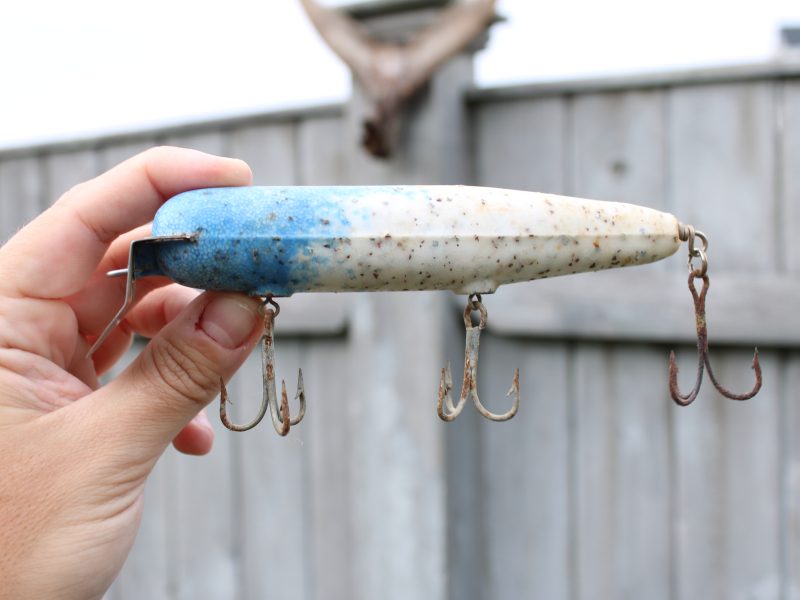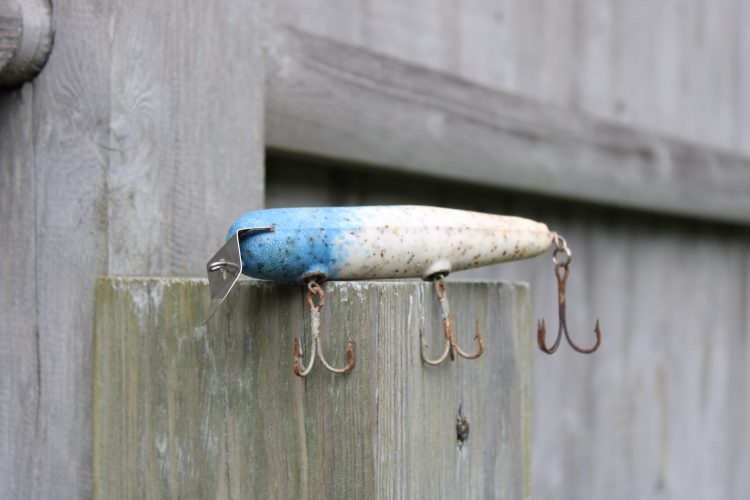Historic Striper Plugs: Atom Lures
In the 1940's, Bob Pond helped pioneer the evolution of striper plugs with the Atom 40—the first saltwater-grade metal-lipped swimmer.

The story of how Atom Lures came about has been told many times over. Some versions even approach urban legend status. Prior to the 1940s, swimming surface lures were primarily designed for freshwater game fish such as pike and largemouth bass, and these lures were not at all built to withstand the rigors of saltwater sport fishing. Most striped bass that were caught by anglers at the time were enticed by using bait on the bottom. If the bass were feeding up on the surface, they were very hard to catch.
During the fall run of 1944, Pond was observing a surfcaster who was having great success catching surface-busting bass on the Cape Cod Canal. Despite Bob’s best efforts, the furtive surfcaster managed to keep his secret safe from Bob’s prying eyes. Several weeks later, Pond was back fishing on the banks of the Canal. He looked down and noticed an old, beat-up Creek Chub lure floating in the water. He reached down, plucked it from the water and looked it over. Pond concluded that the lost lure must have been the secret that was responsible for the success of the previous angler with the surface-busting stripers. Intrigued, he tied the battered old lure onto his line and enjoyed similar success. Energized by his discovery, he took the plug back to his Attleboro, Massachusetts home to see if he could reproduce the lure and improve it for saltwater use.
Pond began by creating rough copies made from old wooden curtain rods. Once he was satisfied with his first prototypes, he returned to the Canal to test them out and had great success. That winter, Pond purchased a lathe, woodworking tools, and lure-making components. Over the next several months, he proceeded to build his first hand-made lineup of wooden, saltwater swimming lures. They were similar to the Creek Chub Pikie, but heavier and sturdier for saltwater use. The following season he began selling the first generation of swimming prototypes along the banks of the Cape Cod Canal, right from the trunk of his car.
Over time, Pond improved on the prototypes, giving them more buoyancy, weight and action. By the fall of 1945, Pond’s new plug even had a name, “the Striper Atom,” named after the recently detonated atomic bombs that helped bring an end to World War II. “Atom” also served as the founding name of the company. The original Striper Atom swimmer was finished in three basic color schemes: Herring Blue, Whiting Gold, and Blue & Silver. As the lures increased in popularity, Pond expanded and improved the design even further, using high-quality paint finishes and machine-stamped lips, rather than hand-fashioning them from tin.
Initially, much of Pond’s time was devoted to acquiring raw materials – wooden chair legs, old broom handles and whatever he could lay his hands on – to make his lures. “That’s one of the reasons why the (early) plugs are so different,” said Ron McKee, a close friend of Pond’s who worked with him for more than 30 years. “You might have some that were made out of cedar, you might have some made out of pine, some made out of ash, some made out of maple. He used anything that was large enough in diameter to make the lures.” In the late 1940s, Pond decided to switch the manufacturing process from wood to plastic. This not only cut his material costs, but helped separate his lures from many similar styles that were flooding the market. Plastic models were also more consistent in action and durability from one lure to the next. Using a “super-tough” ethyline-based material, the new Atom Lures were guaranteed not to chip, crack, or absorb water, unlike most wooden lures. Pond started by designing a plastic version of the original swimmer, designated the P40. “The P40s were made in halves,” explained McKee, “glued together, with a bent wire in the middle.” From then on, updated models were numbered, coinciding with the year they were released, such as the Atom P51, P54, and so on.

Even with the success of his early models, Pond never stopped experimenting. He regularly talked to surf anglers, soliciting new ideas all along the entire striper coast. “It was somewhere around 1950 when he came out with the idea [for] the Reverse Atom,” said McKee. “That’s when guys were taking hooks off of plugs to get them to cast farther. They’d take some of the big swimmers and take the lips off them. Then they’d take the tail hook off and put it where the lip was, and they would cast the plugs backward. Bob saw people do that to his plugs, and some of the guys asked him if he could turn it around so they could cast them farther, because the P40 did cast like a kite.”
During the 1950s, Pond introduced the first flat-nosed Atom poppers, made out of a hardened, pressurized, Styrofoam compound. Over time, he continued to tinker with the design, changing the nose cups to create different surface effects for different models. Examples include the Atomizer, Striper Swiper, and the Swinging Swiper (with dual, free-swinging single hooks) just to name a few. As the popularity of Atom lures grew, so did the variety of styles, models, and colors. “There are as many colors of Atom P40s out there, and Atom popper plugs, as there are ideas,” declared McKee, “because sometimes Bob would let us experiment. And sometimes he experimented. He tried different things.” A personable, friendly man by nature, there was never any shortage of people volunteering to help Bob Pond in his Attleboro shop.
As the years passed, much of Atom’s notoriety came by word of mouth, passed on from angler to angler, and from the lips of Bob Pond himself. He always remained active, traveling the Eastern Seaboard introducing his Atom lures to tackle shops and promoting them in surf-fishing clubs. Across decades, Pond taught countless anglers how to catch striped bass using his plugs, while spreading love and appreciation for the fishery.
By the mid 1960s, Pond was becoming almost as well known for his activism on behalf of striped bass as he was for his classic lures. He was one of the first, (as both a surfcaster and businessman), to raise concerns about declining populations of striped bass. He committed much his own money earned from lure sales to fund research, enlisting the help of scientists, biologists and hatchery workers. As the founder of the conservationist fishing club Stripers Unlimited, Pond mobilized and lobbied hard on behalf of striped bass. He was dogged, determined, and at times quite candid, throughout the process. Thanks to Pond’s tireless efforts and others like him, the 1979 Emergency Striped Bass Act (sponsored by Senator John Chafee of Rhode Island) was enacted, which initiated studies to uncover the reasons behind the decline in striped bass populations and lead toward measures for restoration.
Pond continued balancing his work with Stripers Unlimited and Atom Lures until 1998, when he made the difficult decision to sell the business. “Bob didn’t think the business made money,” explained McKee, “because every single penny the business made, Bob put into Stripers Unlimited and striped bass preservation and research. Every penny. If he could squeeze a dime out of a grape nut, he did it,” he laughed. “But the bad part is that he was turning over huge numbers of plugs. There were markets he was turning his back on because he was so tied up with the research stuff on the striped bass, and making sure the striped bass maintained.” Within Pond’s loyal, tight-knit surfcasting community there was no shortage of potential suitors. Ultimately however, he decided to sell the assets of Atom Manufacturing Company to Greg Metcalf and Larry Razza of Smoker Baits, who moved the manufacturing operation to Costa Rica. Four years later, the rights to Atom Lures were purchased by Uncle Josh Bait Co., where they remain today.
Bob Pond was an old-school lure maker and surf-fishing pioneer, designing and building saltwater lures during the golden age when surfcasting was at its peak. “I wouldn’t say he was the first,” McKee pointed out, “there were about a half dozen or so. There was him, Stan Gibbs, Jerry Sylvester, Floyd Roman, and they all had different ideas. They were all hard-core fishermen, every one of them. There was a small market back then for striper lures… and Bob, I think he probably put the most effort into [surface plugs] as anybody. He developed ideas that were just unbelieveable.”
The passing of Atom Lures founder Bob Pond in December 2009 (at age 92) brought forth a tidal wave of admiration and heartfelt remembrances. One of the first classic, old-school saltwater plug builders, Pond was a passionate surfcaster and striped bass activist who is widely credited for helping prevent the striped bass from disappearing in Northeast waters.
Find Atom Lures at acmetackle.com
Related Content
2 on “Historic Striper Plugs: Atom Lures”
-
Bob Zumwalt Was a go to plug in the seventy. Many Rhode Island stripers fell that plug. My personal best 54lbs 10 onz Bass fell to that exact Blue white swimmer June of 77.
-
Jason Haines I live in Attleboro, it’s nice to know such a New England surf casting icon was made here. My old man landed many stripers back in the 60s and 70s on atoms and Gibbs poppers. I took have had luck with an atoms swimmer, outgoing tide, late season, just let it swim in the current and WHAM I remember my dad telling me they would fish them back wards during the squid run. Great article, thanks!
Leave a Reply